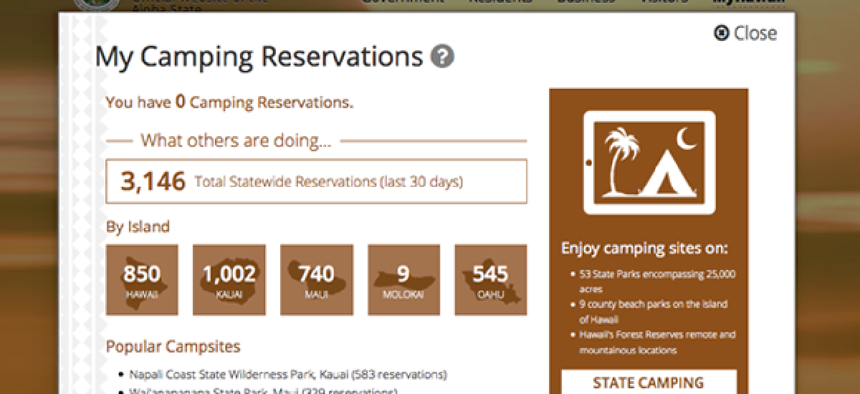Hawaii wins with gamification of state online services


Connecting state and local government leaders
By applying gaming elements to its websites, Hawaii has boosted citizens’ use of online services by as much as 20 percent.
The words “government” and “game” don’t often go together – at least not in a positive way. But officials in Hawaii are adding gaming-based features to the state’s web services to drive citizen engagement.
“A typical reaction was, ‘I’m sorry, gamification in government?’ Those two words – don’t juxtapose them,” Sanjeev “Sonny” Bhagowalia, Hawaii's former chief information officer and current chief adviser to the governor on technology and cybersecurity, said of state workers’ response to the idea. “Sometimes we are kind of a no-fun zone or no-thrills zone, so to speak.”
Hawaii is the first state to apply gaming components to its web services and the response has been encouraging so far. About 400,000 users are registered on the site already, and overall adoption of online services is up as much as 20 percent, according to an article on Transform Hawaii Government.
The idea came from Russell Castagnaro, general manager of Hawaii.gov, the state’s e-government portal, and the Hawaii Information Consortium (HIC), a subsidiary of e-gov company NIC. Inspired by the book “For the Win: How Game Thinking Can Revolutionize Your Business,” he took three main gaming elements – badges, leaderboards and points – and tweaked them to entice more users to state websites via my.hawaii.gov, launched in April as a one-stop shop for citizens’ government needs and services.
For instance, badges are issued to let users see how much time or paper they saved or how many miles they avoided by conducting government transactions online. A community board, rather than a leaderboard, lets them also see aggregate savings of all users.
Effective cross-promotion of government services online was a major objective of the project – and a challenge. Some services have 75 percent adoption, while others only 5 percent, Castagnaro said, even though the same people are using the services. To change that, he paired services, “so that when people apply online for a professional or vocational license, they can also see other services related to their business, and that drove up adoption,” according to the Transform Hawaii Government article.
To facilitate widespread use, my.hawaii.gov provides a single sign-on access so that someone who needs to file a birth certificate can also reserve a campground or check procurements with the same user name and password.
“All of our applications share common credentials and permissions,” Castagnaro said. “The missing element to all that was, ‘What’s an easy way to share that data in a way that’s not monolithic?’”
Castagnaro turned to technologies such as Foundation and jQuery, a cross-platform JavaScript library, as well as the data.hawaii.gov open data portal to build credentialized data feeds on top of open data. Most of the applications are Java-based.
“We’re putting it out there in a standard way that anybody could access with the right credentials, and we’re making an application framework around it,” he said.
Single sign-on also lets other state offices administer and access portal services such as the state calendar, Charity Search and Mortgage Foreclosure Dispute Resolution System, according to a 2013 annual report from HIC.
For ease of use and operational transparency, Castagnaro and his team added notifications so that users can get email or text alerts on the status of a business license application, for example.
Working off Bhagowalia’s plan to have a fully digital government that can be accessed from any device, the team used responsive design on the sites so they scale to any device. They also launched about 10 mobile apps.
To guard information, including personally identifiable and financial data, all websites are protected by the Secure Sockets Layer protocol, have in-line intrusion-detection countermeasures, are patched frequently and undergo independent quarterly audits. They also comply with the Payment Card Industry digital security standards and Sarbanes-Oxley accounting requirements.
“We’re taking every countermeasure that we can, and when we find new ones, we deploy them immediately,” Castagnaro said.
He and Bhagowalia began working together in a public/private partnership in 2011, when Bhagowalia became Hawaii’s first CIO and found most systems were at least 30 years behind the times. After a year of developing an award-winning transformation plan, work on Hawaii.gov began. In September, the Web Marketing Association named it the best government website.
Still, plenty of work is left, Bhagowalia said. Among the next tasks at hand is integrating or reducing the hundreds of legacy applications now sitting behind the new ones.
“We still have a big iceberg over there that we have to chip away at,” he said.
Editor's note: this article was changed Oct. 20 correct the spelling of Russell Castagnaro's name.
NEXT STORY: Taking aim at stealthy attacks




